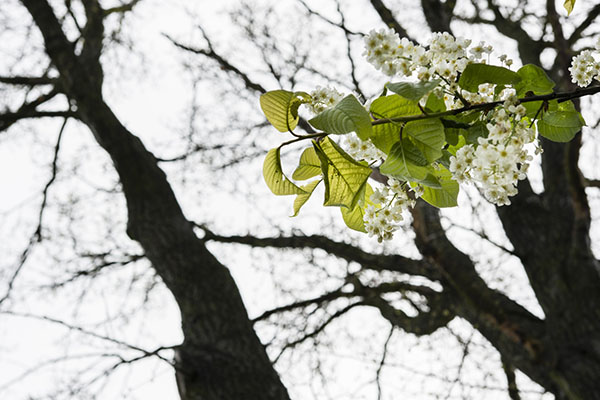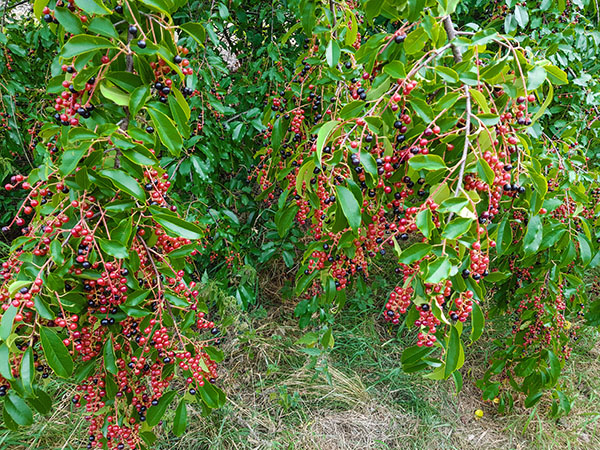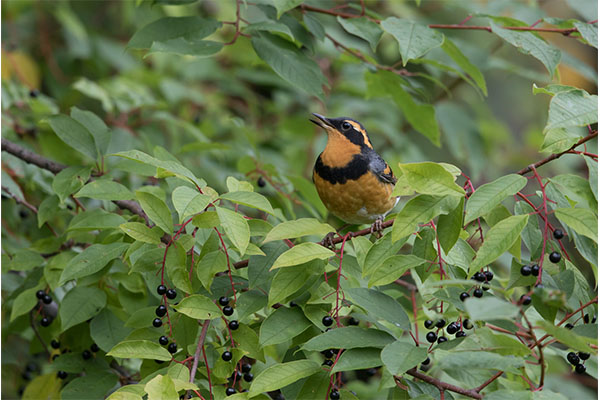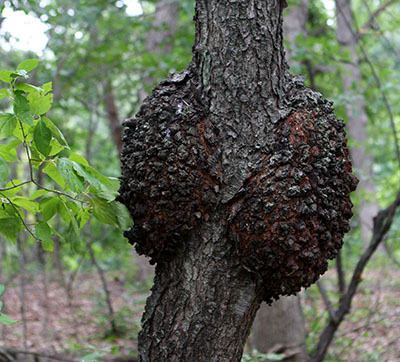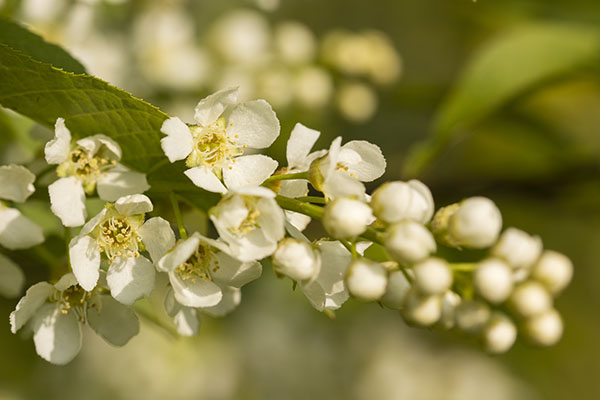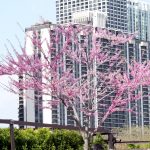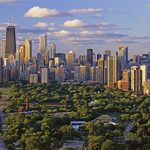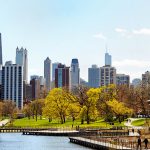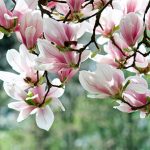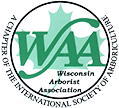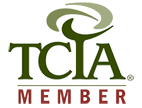Our ongoing series covering the native trees of the Chicago area returns this week with a closer look at the beautiful and showy black cherry tree. The black cherry tree (Prunus serotina), also known as the mountain black cherry, rum cherry, and wild black cherry, is a large deciduous tree that is found throughout the eastern half of the United States as well as areas in the American Southwest and Mexico. Black cherries are commonly used as shade trees because of their large size but their showy flower clusters and fruits make them an excellent choice for an ornamental tree as well. These trees belong to the genus Prunus which includes other fruit bearing trees such as cherries, plums, peaches, apricots, and nectarines.
There are so many different types of cherry trees that are found throughout the world in the temperate regions of the northern hemisphere. Most cherry tree species are found in the eastern hemisphere and there are about 10 varieties of cherry trees in the western hemisphere including North and South America. Of the varieties of cherry trees found in the U.S., only a few are native to the Chicago area. For our purposes, we are going to focus mainly on the black cherry tree because it is a common and very beautiful native tree in our local area. We will also touch on other native species of cherry trees you are likely to find in the Chicago area.
In this guide, we will discuss the black cherry tree including its characteristics, its main threats from diseases and insects, and proper care tips to keep your black cherry trees strong and healthy. We will also discuss other cherry tree species that are native to the Chicago area. If you have a black cherry tree on your property and you want to ensure it is properly cared for, call our professional arborists at Hendricksen Tree Care. We are an ISA certified tree care service provider that can effectively care for your trees with regular maintenance, treatments for insects and disease, and tree pruning services.
Characteristics of Black Cherry Trees
The black cherry is a woody species of cherry tree that can grow up to 80 feet tall. They can be easily identified by several characteristics including its dark colored, broken bark, clusters of small white pedaled flowers, and pendulous groups of reddish black cherries. The main characteristics of black cherry trees are explained below in greater detail:
- Height: Black cherry trees are among the largest of the cherry trees, generally growing to be between 50 and 80 feet tall. Other species of cherry trees such as the chokecherry can grow as tall as 25 feet and be as small as an 8-foot shrub.
- Leaves: The leaves of most cherry tree species are slender oval-shaped leaves that come to a point at the end with very finely serrated edges. They are typically dark green during the growing season and they turn vibrant shades of yellow, orange, and red in the fall.
- Flowers: The black cherry tree and other native cherry tree species have small, white 5-pedaled flowers that grow in elongated clusters. They appear late in the spring and give off a strong odor often described as unpleasant.
- Fruit: One of the most distinctive characteristic of black cherry trees, and other species of cherry trees, is their fruit. The fruit on most cherry trees are edible cherries or drupes that appear in large clusters and are reddish black to purple in color. The fruit of black cherry trees appear in large drooping clusters and are typically dark red or black in color.
- Bark: The bark of an immature black cherry tree is smooth and greenish brown in color. As the tree matures, the bark becomes dark gray or black in color and appears as large broken flakes.
Native Species of Cherry Trees in Chicagoland
As we mentioned earlier, we are focusing on the black cherry tree because it is one of the most common types of cherry trees found in the Chicago area. However, it is not the only one as the following cherry tree species are also native in our area:
- Chokecherry: The chokecherry (Prunus virginiana), also known as the bitter-berry chokecherry, Virginia bird cherry, and western chokecherry, is closely related to the black cherry tree. Unlike the black cherry tree, however, the chokecherry is very small in size. They typically appear as small 10-25 foot trees or 8 foot suckering shrubs. The flowers and leaves of the chokecherry look similar to those of the black cherry tree, but their fruits are typically purple when ripe and have a sour, bitter taste to them.
- Pin Cherry: Pin cherry (Prunus pensylvanica) trees are small, fast-growing trees that have a relatively short lifespan. The can grow anywhere between 15 and 40 feet tall and they grow well in dry, sandy soil in the sun. The leaves and fruits are once again similar to those of the black cherry tree, but it differs in its bark. The bark of an immature pin cherry is reddish bronze in color and it develops red horizontal lenticels as it matures.
Natural Threats to Black Cherry Trees
Black cherry trees are always vulnerable to a number of pests and diseases that can lead to defoliation, trunk damage, and even the death of the tree. Diseases like black knot can very quickly kill an entire black cherry tree and pests like the tent caterpillar can cause it very serious harm. The following are the most common diseases and insects to look out for on your black cherry trees:
Diseases
-
Black Knot: Black knot is a serious fungal disease that can cause damage to the branches, twigs, and fruit spurs of the black cherry tree. The infected areas of the tree will produce excess bark and wood tissues that become swellings that are light brown in color. These swellings, or galls, will continue to grow in size and eventually rupture and release its spores which will only spread the disease. As the gall enlarges, it kills the affected twigs and branches. Smaller twigs may die within a year while larger branches can last for several years before the disease eventually kills them. The tree will slowly weaken and die if the disease is not treated. Effective maintenance and pruning can help prevent black knot.
- Cherry Leaf Spot: Cherry leaf spot is another fungal disease that mostly attacks the leaves but can also attack twigs and stems. This disease is more likely to occur in humid conditions. Leaves affected by cherry leaf spot will have dark spots with red borders on top of the leaves and a white waxy substance on the underside. The affected leaves will eventually yellow and fall off the tree prematurely, leading to noticeable defoliation. It is possible to treat trees affected by cherry leaf spot with pruning. If you do not feel comfortable pruning your tree with cherry leaf spot, you should call a professional arborist.
- Brown Rot: Brown rot is a fungal disease that attacks the fruit, flowers, and small branches of black cherry trees. If your cherry tree has signs of blight, cankers, or rotting fruit, it is likely affected by brown rot. The affected fruit will start to shrivel quickly and will become covered by a substance that is brownish gray in color. Because of the appearance of the affected fruits, they are commonly referred to as mummified fruit. Powdery brownish gray spores will also appear on the surface of affected flower shucks and twigs. It is important for the fruit and flowers infected by brown rot to be removed from the tree with pruning while it is dormant.
Insects
- Eastern Tent Caterpillars: Eastern tent caterpillars are one of the biggest threats to black cherry trees and can result in extensive defoliation. The eggs of the tent caterpillar are laid as an egg mass and the eggs hatch in the spring. Immediately after hatching, the caterpillars build silk webs, or tents, in the forks of the tree and spend their time feeding on the foliage before returning to the tent at night. Older caterpillars spend their days in the tents and feed at night. These caterpillars are generally black in color with a white stripe running down their backs. When the caterpillars mature, they will leave the tree to form a cocoon and come back as adult moths two weeks later to lay eggs that overwinter before hatching in the spring. Adult moths are reddish brown in color with two diagonal white stripes on each wing.
- Black Cherry Aphids: Black cherry aphids are aphids that exclusively attack black cherry trees. These aphids are small, round black insects that feed on the sap of the tree. This can lead to stunted or deformed leaves and honeydew secretions from the aphids on the leaves and fruits. The honeydew secretions can also lead to the growth of a black fungus on the affected spots.
- Borers: Like most tree types, black cherry trees are susceptible to infestations and damage from borers. The borers that present a threat to the black cherry tree are the Shot Hole Borer and the Peach Tree Borer. Shot Hole Borers are light brown in color with oval shaped bodies and Peach Tree Borers are skinny winged insects that are black in color with one horizontal orange stripe on its body. Borers cause serious damage in their larval stage by boring into the sap wood and interrupting the flow of nutrients. They also create tunnels in the wood that can cause the tree to weaken. When the borers mature, they emerge as adults and lay eggs in the bark of the tree. Treatment for borer infestations will depend largely on the severity of the damage.
Black Cherry Tree Care Tips
Black cherry trees are beautiful additions to yards and landscapes with their showy fruit, flowers, and fall colors. Providing effective care for these trees will help preserve their beauty and help them resist insects and disease to remain healthy. Make sure you care for your black cherry trees with the following tips:
- Planting: Black cherry trees are best planted in the fall, but they can be planted in the early spring as well after the ground has thawed. Choose an area for your cherry tree that has high exposure to sunlight. These trees can tolerate dry, acidic soil conditions so find an area that is also well drained. New plantings need to be watered regularly for the first few months.
- Watering: Established black cherry trees need very little watering in the beginning of the season unless it has been especially hot or windy. However, they do require watering once the fruit starts to develop. Water only when the top 2-3 inches of the soil is dry, and water slowly and deeply. You should also give the tree a good, long watering in the fall before the winter.
- Mulching: Laying down organic mulch around the drip line of the tree will help the root system better retain moisture.
- Fertilization: Black cherry trees need fertilization early in the season to keep them healthy and help with fruit production. You should apply an organic fertilizer that contains 1/8 pound of nitrogen for every inch of the diameter of the trunk. If you aren’t sure what type of fertilizer to use for your tree, contact a professional arborist to provide fertilization.
- Pruning: Black cherry trees benefit from pruning to help improve their appearance and their resistance against certain pests and diseases. Broken, dead, and decaying branches need to be removed to allow more sunlight to reach the interior of the tree. Once again, it is best to have a professional arborist provide tree pruning services if you don’t think you can do the job properly yourself.
Professional Tree Care for Black Cherry Trees
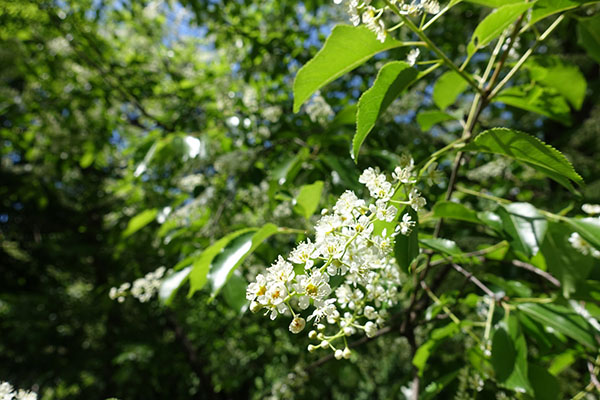
Consider adding the very showy Black Cherry Tree to your Chicagoland residential or corporate landscape in the Fall or Spring!
Black cherry trees are tolerant of tough conditions like dry and acidic soil, but they are also vulnerable to diseases without effective care. Fertilization and pruning can help protect black cherry trees from black knot, tent caterpillars, and other major threats. If you want to ensure that your black cherry trees remain in good health, the professional arborists of Hendricksen Tree Care are here to help.
Hendricksen Tree Care provides complete tree care and maintenance services in the Chicago area to help care for all types of trees including black cherry trees. Our tree care includes fertilization, pruning, and treatments for insect infestations and diseases. We will provide ongoing care for your trees to ensure that they get the preventative treatments and fertilization they need to stay healthy and vibrant throughout the growing season. Hendricksen Tree Care is ready to serve homes and businesses in the north and northwest Chicago suburbs including Arlington Heights, Lake Zurich, Northbrook, Highland Park, Barrington, Palatine, Libertyville, and surrounding areas in Illinois.
Stay tuned for the next edition of our series about the native trees of Chicago.
